Looking at the work of master metalsmith Carlo Scarpa
By Naomi Evans, Architect at Cox Architecture, Melbourne, Australia
As Christmas approaches, an advertisement is currently airing on Australian television for a high- profile department store. The marketing campaign has coined the phrase, “find wonderful” and the ad, with cinematic flair, follows a pretty ingénue as she weaves her way through a whimsical paper city and poses the question, “ever wonder where wonderful went?” As children, the story suggests, we found delight in little details. We were enthralled by life’s small offerings, and “fairies paid good money for teeth.” But as we’ve grown in age, acquisitions, and responsibility, we’ve all got serious.
“Suddenly, the world became one great, grey blah of adequate.”
Naturally, the proposition of the ad is that ‘wonderful’ is sitting on a shelf or hanging on a coat rack in the aisles of a store somewhere near you. With a penny in your pocket you can buy it and reclaim your youthful wonder-lust! Yes, it’s pretty flippant…aren’t all commercials? But I really like this ad. It’s beautiful to watch, and my intention is not to trivialise the message as mere marketing spin. This nostalgic narrative rings true, and I’m inclined to agree that worldly wisdom has a tendency to make us less frivolous, less appreciative, and less imaginative.
Modernism, brutalism and minimalism
If your interest lies in architecture, a brief exploration of the 20th Century is enough to see that design ‘grew up’ with the dawning of the Modernist Movement when a functional approach was favoured and every element served a purpose. Brutalism and minimalism were the extreme expressions of this school of thought, scorning ornament and leaving a legacy of cold, cavernous buildings. These monuments are now valued for their representation of a particular time and ideology, but visitors to the Birmingham Central Library, or to Balfron Tower on London’s Brownfield Estate, would surely be forgiven for feeling one great, grey blah of adequate. Perhaps this goes some way to explaining why Birmingham’ sold library is on the brink of demolition. Typical of brutalist architecture, this building is all about the macro composition and is best viewed from a distance to appreciate its inverted Ziggurat form. Close up, there’s not much of interest.
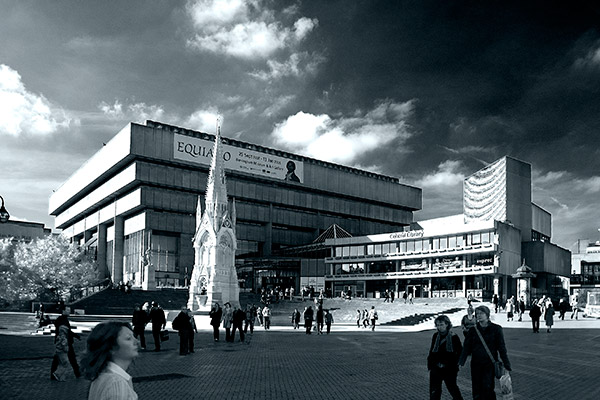
Birmingham Central Library
Carlo Scarpa, Master Metalsmith
Of course not all proponents of Modernist design subscribed to the belief that detail and adornment were a superfluous waste of time and money. One of my personal favourites, Carlo Scarpa (1906 – 1978) was arguably the Master Metalsmith in an age when the frivolity of the Les Arts Décoratifs seemed a distant memory. His work is characterised by the use of raw and natural materials, primarily concrete. He featured metals such as iron, copper, bronze and brass in little moments of lustrous relief against the monolithic rawness of concrete. Scarpa often chose a semi-precious metal to express the connection between elements; at the foot of a column where it meets the foundation, or for the latch of the door where it touches the wall. You can see this treatment at the Banca Popolare in Verona where Scarpa introduces cast brass clamps to fix a handrail to the baluster. Also at the Tomba Brion Cemetery where a simple stainless steel handle glistens against the concrete gate it opens.
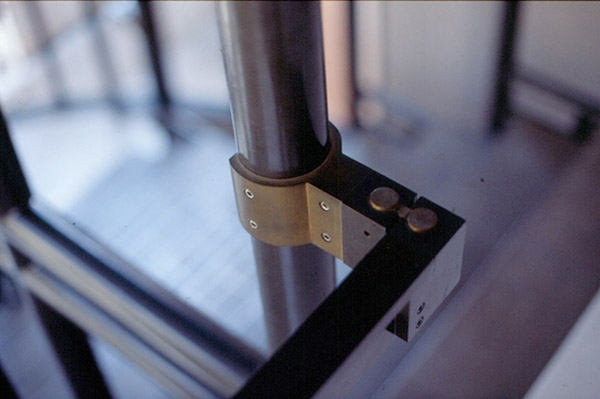
Scarpa’s cast brass clamp to fix a handrail to the baluster Banca Popolare in Verona
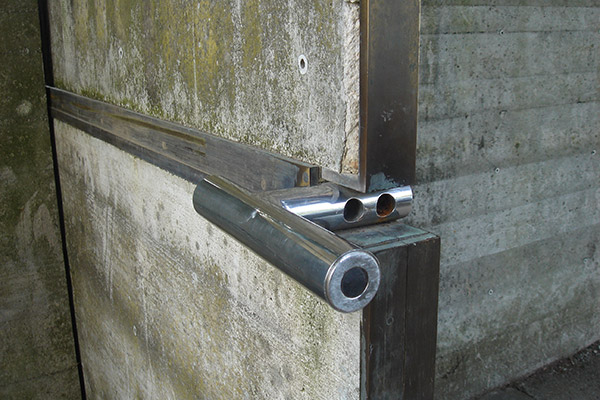
Stainless steel handle, Tomba Brion Cemetery, San Vito d’Altivole near Treviso, Italy
Scarpa always used metals in pure form, never galvanised, coated, painted or treated. The same applied to his use of timber. He was known for being actively involved in the fabrication of his details and collaborated with craftsmen producing detailed drawings to communicate his design intent. My all-time favourite Scarpa moment is his fountain at the Querini Stampalia in Venice which I was privileged to visit earlier this year. The fountain spurt is fabricated from cantilevering tubular wrought iron, and the basin is formed from marble. The design is completely unfussy, but Scarpa has clearly given it great thought. The trough sits low to the ground and steps down in a linear series of mini-terraces. It’s perfectly integrated in the landscape, and reminiscent of a river running through.
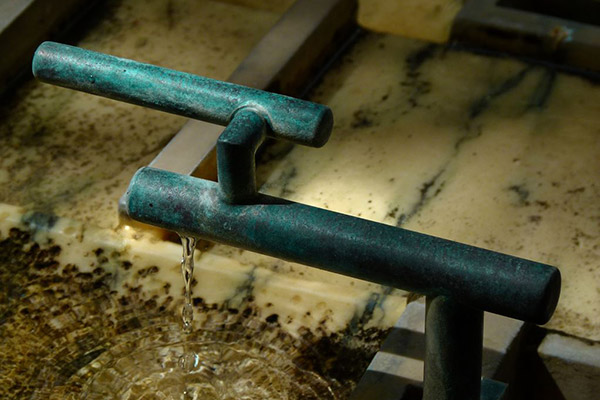
Scarpa’s tubular iron fountain at the Querini Stampalia in Venice
Tristan Auer
With the advent of the 21st Century, the age of minimalism has all but ended. The slick white interiors that recently filled our architectural magazines are now increasingly relegated to corporate commercial fit outs and car dealerships. It seems that contemporary society is no longer enamoured with stark spaces… are we perhaps searching for a touch of wonder in our homes, our offices, and public places? A predilection for warm materials, timbers, and copper alloys such as bronze and brass are particularly evident in new fit-outs for the hotel, bar and restaurant industry.
I recently stumbled across the work of French Interior Architect Tristan Auer on Pinterest and was immediately taken with a photograph of a beautiful bronze door handle for a private residence in La Muette, Paris. The craftsmanship of the handle seemed to belong to a bygone era, recalling the geometric designs that characterised Les Arts Décoratifs in the 1920s. Another image showed a wardrobe spanning the full width of a bedroom, concealed behind floor to ceiling timber panels. Then in a moment of relief, a brushed, brass-lined shelf punctuates the timber with a shadow line detail setting it apart from its timber host.
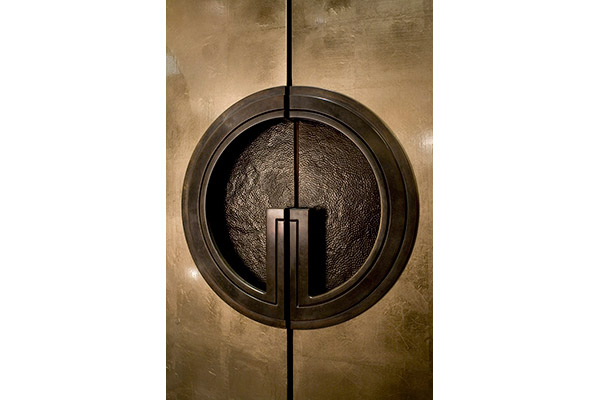
Bronze door handle by Tristan Auer for a residence in La Muette, Paris.
Francois Champsaur and the Hôtel Vernet, Paris
Both Auer and fellow countryman Francois Champsaur build on the legacy of Scarpa and have gained international recognition for their use of bronze patinated brass, and patinated steel in their bespoke designs for furniture and light fittings. Lacquered steel and brushed metals feature heavily. In his 2014 refurbishment of the famed Hôtel Vernet in Paris, Champsaur’s use of copper alloys to articulate certain elements shows an indulgent delight in his workmanship. The brass mesh screens that frame the small entry lobby shimmer in contrast to the fresh white walls and ceilings throughout the rest of the Hôtel.
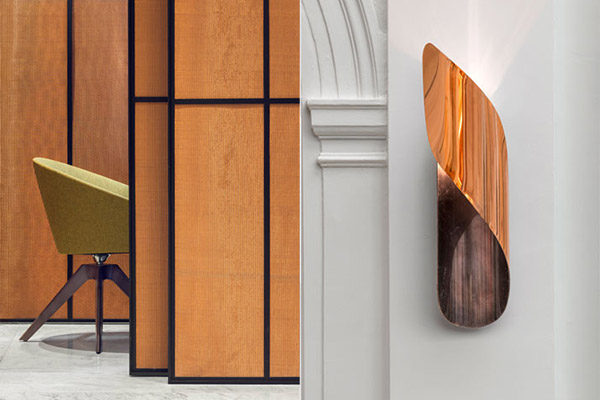
Lobby of Hôtel Vernet. Folded copper bracket lamp designed by François Champsaur and fabricated by Pouenat.
Brass mesh screen designed by François Champsaur and fabricated by Gendre.
Photograph courtesy of Hôtel Vernet.
It seems often the way that it’s the small details you remember. A change in material, or a change in angle. Something sparkling unexpectedly. For Scarpa, there was logic to every move he made. But for me, as an observer and an appreciator, I see delightful moments of whimsy that are set apart from the general composition and hint at playfulness. There’s much to learn from our Modernist predecessors, but I suspect we will continue to search for little moments of wonder, whimsy and warmth as our great, grey cities expand around us.